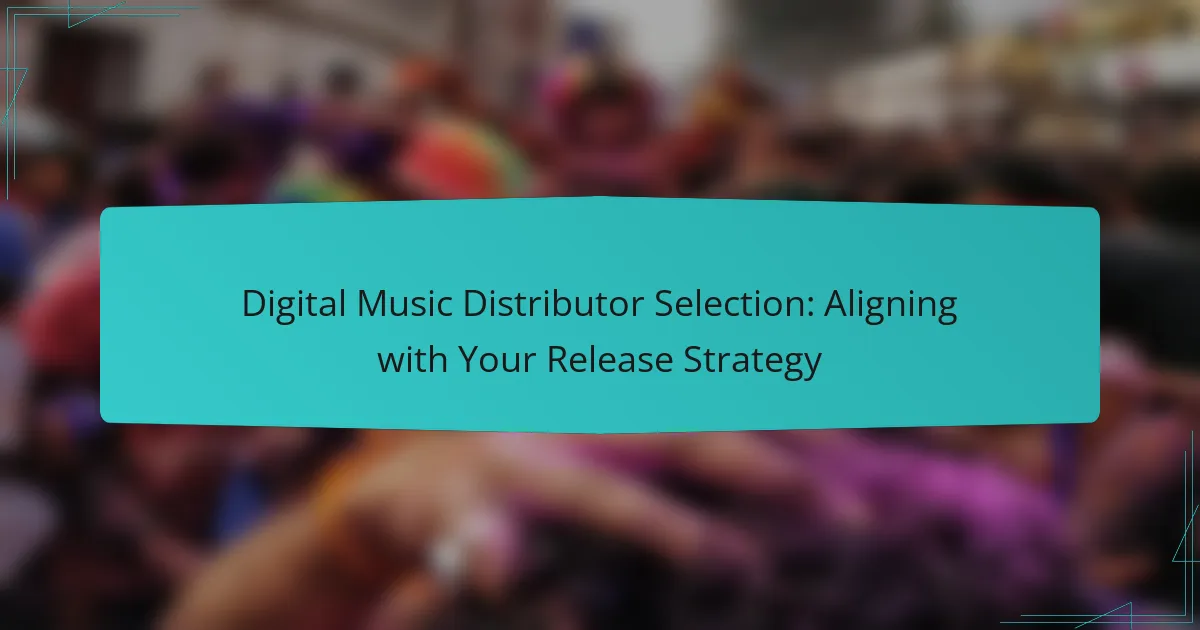Selecting a digital music distributor is essential for successfully implementing your release strategy. By evaluating factors such as reach, pricing, royalties, and customer support, you can ensure that your music is not only distributed effectively but also monetized to its fullest potential.

How to choose a digital music distributor for your release strategy?
Selecting a digital music distributor is crucial for aligning with your release strategy. Consider factors such as reach, pricing, royalties, user experience, and customer support to ensure your music is effectively distributed and monetized.
Evaluate distribution reach
Distribution reach refers to the number and quality of platforms where your music will be available. Look for distributors that can place your tracks on major streaming services like Spotify, Apple Music, and Amazon Music, as well as smaller platforms that cater to niche audiences.
Research the geographical coverage of each distributor. Some may focus on specific regions, while others offer global distribution. A broad reach can significantly increase your chances of gaining listeners and generating revenue.
Assess pricing models
Different digital music distributors offer various pricing models, including flat fees, percentage cuts, or a combination of both. Flat fees can be beneficial if you plan to release multiple tracks, while percentage cuts may be more suitable for occasional releases.
Compare costs across several distributors to determine which model aligns best with your budget. Be mindful of any hidden fees, such as those for additional services like marketing or promotional tools.
Consider royalty structures
Royalty structures dictate how much you earn from your music sales and streams. Some distributors offer higher percentages of royalties, while others may take a larger cut but provide additional services.
Evaluate each distributor’s terms carefully. Look for those that offer transparent royalty reporting and ensure you understand how and when you will receive payments. This can help you avoid surprises down the line.
Review user interface and tools
A user-friendly interface can make the distribution process smoother and more efficient. Check if the distributor provides an intuitive dashboard for managing your releases, tracking performance, and accessing analytics.
Additionally, consider the tools offered for marketing and promotion. Some distributors provide features like social media integration, pre-save campaigns, and email marketing tools, which can enhance your promotional efforts.
Check customer support options
Reliable customer support is essential when navigating any issues that may arise during the distribution process. Look for distributors that offer multiple support channels, such as email, chat, or phone support.
Read reviews or testimonials to gauge the responsiveness and helpfulness of their customer service. A distributor with strong support can save you time and stress, especially during critical release periods.

What are the top digital music distributors in the US?
The top digital music distributors in the US include DistroKid, TuneCore, CD Baby, and AWAL. Each offers unique features and pricing structures that cater to different artist needs and release strategies.
DistroKid
DistroKid is known for its straightforward pricing model, allowing artists to upload unlimited music for a flat annual fee. This makes it an attractive option for musicians who release multiple tracks or albums each year.
One key advantage of DistroKid is its speed; music can be distributed to major platforms like Spotify and Apple Music within a couple of days. However, artists should be aware that DistroKid takes a percentage of earnings from features like YouTube monetization.
TuneCore
TuneCore operates on a pay-per-release basis, charging fees for each single or album uploaded. This can be beneficial for artists who release music less frequently and prefer to pay only when they have new content.
While TuneCore offers a comprehensive distribution network and detailed sales reports, the costs can add up quickly for frequent releases. Artists should weigh the benefits of its analytics tools against the potential expenses.
CD Baby
CD Baby charges a one-time fee for each release, making it a good option for independent artists who want to retain control over their music. They also provide a range of additional services, including physical distribution and sync licensing.
One notable feature of CD Baby is its ability to distribute music to a wide array of platforms, including niche services. However, artists should consider the upfront costs and the percentage CD Baby takes from digital sales.
AWAL
AWAL is a digital distributor that focuses on independent artists, offering a more personalized approach with potential funding opportunities. Unlike other distributors, AWAL does not charge upfront fees but takes a percentage of revenue instead.
This model can be advantageous for emerging artists who may not have the budget for upfront costs. However, AWAL is selective about the artists it accepts, so not all musicians may qualify for their services.

How do pricing models impact distributor selection?
Pricing models significantly influence your choice of digital music distributor by affecting your overall costs and potential revenue. Understanding the differences in pricing structures can help you align your distributor selection with your release strategy and financial goals.
Flat fee vs. percentage cut
Flat fee models charge a set amount for distribution, regardless of your sales volume. This can be beneficial for artists expecting high sales, as it allows for predictable costs and potentially higher profits after reaching a certain sales threshold.
On the other hand, percentage cut models take a portion of your earnings, typically ranging from 10% to 30%. This can be advantageous for new artists with uncertain sales, as it reduces upfront costs but may limit earnings as sales increase. Consider your expected sales volume when choosing between these models.
Annual fees vs. per-release fees
Annual fees require a single payment for unlimited releases within a year, which can be cost-effective for prolific artists. This model encourages frequent releases, as the upfront cost is already covered.
Per-release fees charge for each individual release, which may suit artists with fewer releases or those testing the waters. However, this can add up quickly, so it’s essential to estimate your release frequency and budget accordingly to avoid unexpected expenses.

What features should you look for in a music distributor?
When selecting a music distributor, focus on features that align with your release strategy, such as analytics, social media integration, and marketing support. These elements can significantly impact your ability to reach audiences and track performance effectively.
Analytics and reporting tools
Analytics and reporting tools are essential for understanding how your music performs across various platforms. Look for distributors that provide detailed insights into streaming numbers, audience demographics, and revenue breakdowns. This data can help you make informed decisions about future releases and marketing strategies.
Consider distributors that offer real-time reporting and customizable dashboards. These features allow you to monitor your music’s performance closely and adjust your promotional efforts as needed. Some platforms may also provide comparative analytics against industry benchmarks, which can be valuable for assessing your success.
Social media integration
Social media integration is crucial for promoting your music and engaging with fans. Choose a distributor that allows seamless sharing of your tracks and playlists across popular platforms like Instagram, Facebook, and TikTok. This capability can enhance your visibility and drive traffic to your music.
Additionally, look for tools that facilitate direct links to your social media profiles and encourage fan interaction. Features such as pre-save campaigns and social media ads can help you maximize your reach and build a dedicated following.
Marketing support services
Marketing support services can significantly amplify your music’s reach. Many distributors offer promotional tools, such as email marketing campaigns, playlist placements, and collaborations with influencers. Evaluate what marketing services are included in the distribution package to ensure they align with your goals.
Some distributors may also provide access to industry contacts and promotional opportunities, which can be beneficial for emerging artists. It’s essential to assess the effectiveness of these services and how they can help you connect with your target audience, particularly in competitive markets.

What are the common pitfalls in selecting a distributor?
Selecting a digital music distributor can be challenging, and several common pitfalls can hinder your success. Awareness of these issues can help you make informed decisions that align with your release strategy.
Ignoring hidden fees
Many distributors advertise low upfront costs but may include hidden fees that can significantly increase your expenses. These can include charges for distribution, annual fees, or cuts from your royalties.
To avoid surprises, carefully review the fee structure of potential distributors. Look for any additional costs associated with services like marketing, analytics, or even payment processing.
Overlooking contract terms
Contracts can contain complex terms that may not be immediately clear, leading to unfavorable conditions. Pay close attention to the duration of the contract, termination clauses, and rights to your music.
Consider consulting with a legal expert to ensure you fully understand the implications of the contract. A good distributor should offer transparent terms that align with your long-term goals.
Neglecting genre-specific needs
Different genres may require tailored distribution strategies, and failing to account for these can limit your reach. For instance, electronic music may benefit from platforms that cater specifically to DJs and remixers.
Research distributors that specialize in your genre to ensure they understand your audience and can provide the necessary tools for effective promotion. This can include genre-specific playlists, marketing strategies, and partnerships with relevant platforms.



